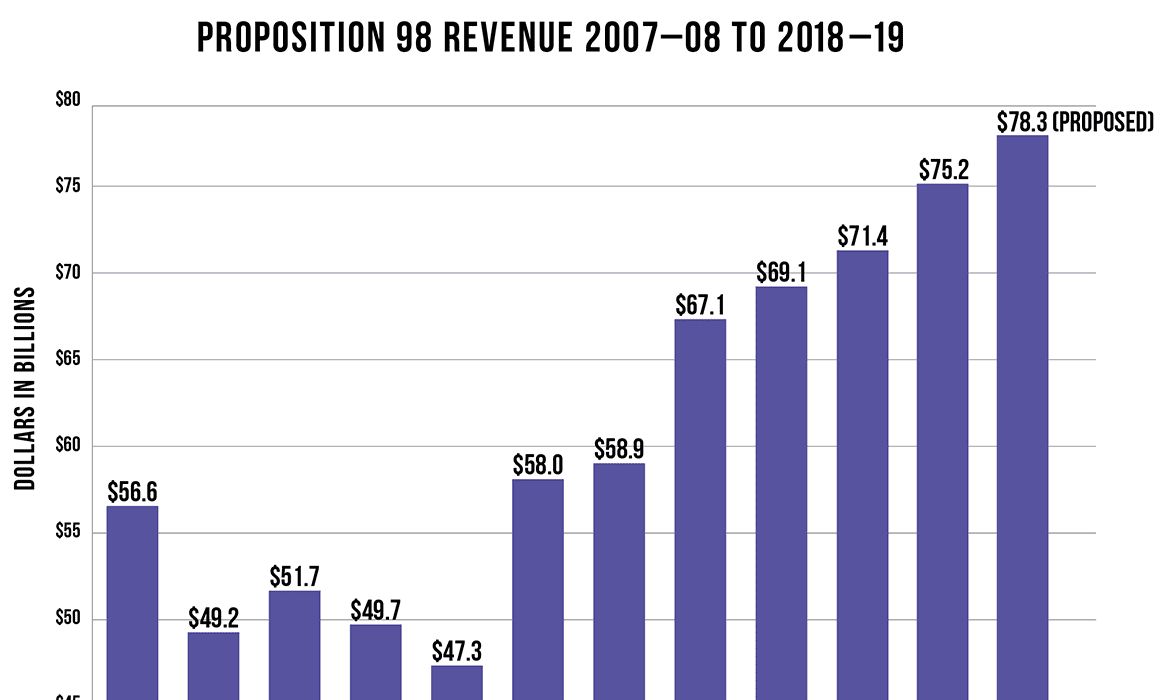

Gov. Jerry Brown
Gov. Jerry Brown’s first draft of the state’s 2018-19 budget, released in January, includes a $190.3 billion spending plan. As a result of increased state revenues and local property taxes, education funding for California’s public schools and community colleges is at an all-time high of $78.3 billion (see chart).
Proposition 98, passed in 1988, guarantees a minimum level of funding be spent on K-14 education. If the proposed budget is passed, it would mean per-pupil expenditures in 2018-19 of $16,085, an increase from $15,654 in 2017-18.

Prop. 98 guarantees a minimum level of funding to be spent on K-14 education, which in Gov. Brown’s proposed 2018-19 budget plan is $78.3 billion. This would mean total per-pupil expenditures of $16,085, of which $11,614 is Prop. 98 revenue (up 66 percent from the $7,008 per pupil provided in 2011-12), and $4,471 is from federal and local revenue, including district parcel taxes and debt service from school construction bonds.
Brown’s budget fully funds the Local Control Funding Formula, which augments resources for the state’s students of greatest need, and raises the voter-mandated Rainy Day Fund by more than $5 billion to protect against inevitable economic recession.
“We commend Gov. Jerry Brown for his leadership and resolve to deliver a surplus budget that fills the Rainy Day Fund and fully funds the Local Control Funding Formula two years ahead of schedule,” says CTA President Eric Heins. “We’re seeing this increase in revenue, thanks in large part to the overwhelming support of voters who passed Proposition 30 in 2012 and Prop. 55 in 2016 to prevent another round of devastating cuts that were so detrimental to our students.”
In addition, Brown’s budget proposes a $570 million increase, or 4 percent, for community colleges. The University of California and California State University systems would each see a 3 percent increase.
Other highlights of education spending in Brown’s plan:
- $100 million in one-time funding to recruit and train special education teachers to help reverse a critical shortage. Half of the money would establish teacher residencies — a one-year mentoring program for teachers in training. The other half would award competitive grants to districts proposing solutions to the special ed teacher shortage.
- $212 million in ongoing funding to extend career technical education programs under the community colleges’ Strong Workforce Programs to K-12 districts, and $12 million to hire local industry experts for technical expertise in setting up the programs.
Heins praises the funding for induction programs for beginning teachers and professional development. “At a time when we face a critical teacher shortage, we must do everything possible to attract and retain the most qualified to our profession,” he says. “The proposed increases in funding for special education, the state preschool program, child care, and health care for low-income families are also critically important.”
Brown’s budget also sets aside $120 million to create a new online community college program geared toward working adults. Higher education advocates and others responded with some reservations, as they have traditionally urged funds go to bolstering existing in-person programs and institutions.
Heins says that further discussion on the topic is warranted. “We are taking a closer look and have some concerns about a few items, such as the online community college and the proposed funding for the vital UC and CSU systems. We look forward to having meaningful conversations and working with the governor and the Legislature to ensure they enact a budget that provides all students with the quality public education they need and deserve.”
Brown will present a revised 2018-19 proposal in May. The state Legislature is expected to pass a budget by June 15.
CFA Protests Lack of Student Access to CSU System
Last year, California State University turned away a record numbers of qualified applicants — 1 in 10, or 31,000 — for lack of space. California Faculty Association leaders and others say the 3 percent increase for the 23-campus CSU system proposed in Gov. Jerry Brown’s 2018-19 state budget is not enough to help fix the problem.
On Jan. 11, the same day Brown unveiled his budget, CFA members staged a pop-up art installation called “Every Student Deserves a Seat — Fund the CSU” on the north lawn of the State Capitol.

Pop-up art installation at the State Capitol with 1,507 empty chairs, each representing 20 qualified students turned away from CSU for lack of space. Photo by Erika Sizemore.
The installation — 1,507 empty white chairs, with each seat representing 20 qualified students — was meant to symbolize the increasing lack of access to CSU and quality public higher education.
Brown’s plan proposes $92.1 million in additional state funding for the CSU. CFA is calling for an additional $422.6 million in state funding, which would allow for healthy enrollment growth of an additional 18,205 students.
“By not allowing qualified students access, we’re failing them before they even have a chance to walk in the classroom,” says CFA President Jennifer Eagan. “It’s time for our state to stand up for the CSU — for our students, for our university, and for the future of California.”
See calfac.org for more information.
The Discussion 0 comments Post a Comment